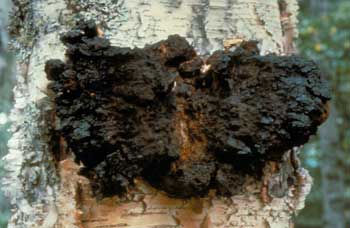Contents:
Common Names | Parts Usually Used | Plant(s) & Culture | Where Found | Medicinal Properties
Legends, Myths and Stories | Uses | Formulas or Dosages | How Sold | Bibliography
Scientific Names

- Inonotus obliquus
- Polyporaceae
Common Names
- Birch mushroom
Parts Usually Used
The 3rd layer (inner granulated parts)
Back to Top
Description of Plant(s) and Culture
Chaga is a fungus-type growth, known as a mushroom, that also grows on beech and other trees. The growth is rough, dry, porous, crusty. It has deeply cut and crooked separations that have the appearance of dull charred wood on the outside. The surface is almost black. When sawn off the tree, it appears as though the tree is having a wart removed. There are 3 layers: 1. outside, rough with old bark and some twigs that must be cleaned off, 2. inside, soft, very close to the tree and must be cut off, 3. the middle part that is granulated and not spoiled, it is the part to use. Collect any time of the year. Store in a dry and dark place in a covered jar, as dampness and strong light dissipate its power.
Back to Top
Where Found
A growth on birch, beech and other trees.
Back to Top
Medicinal Properties
Anodyne, blood purifier, restorative, tonic
Back to Top
Legends, Myths and Stories
Chaga has a long list of uses by Herbal Folk Medicine. Scientifically, nothing of importance was found. But Dr. Froben, showed cases of cancer that remain positive, despite the scientific failure. Since 1955, the Medical Academy of Science in Moscow has promoted Chaga for clinical and domestic medicine.
Back to Top
Uses
Used for stomach complaints, gastritis, stomach ulcers, cancer, tuberculosis of the bones, will stop pain, and slow down or stop tumor growths. Treatment times recommended are from 3 to 5 months, with 7 to 10 day intervals. Chaga needs time.
Back to Top
Formulas or Dosages
When preparing Chaga, think of it as yeast. Water too hot will kill the living fungus.
Infusion: 1 part of crushed Chaga poured over 5 parts cooled boiled (not boiling) water. Let stand covered 48 hours, strain, and again poured over 5 parts cooled boiled (not boiling) water. Drink 3 cups per day 30 minutes before each meal.
Back to Top
How Sold
Solid extract, powder, and tablets dissolved in water, use as directed.
Back to Top
Bibliography
![]() Indian Herbalogy of North America
Indian Herbalogy of North America, by Alma R. Hutchens, Shambala Publications, Inc., Horticultural Hall, 300 Massachusetts Avenue, Boston, Massachusetts 02115, 1973
